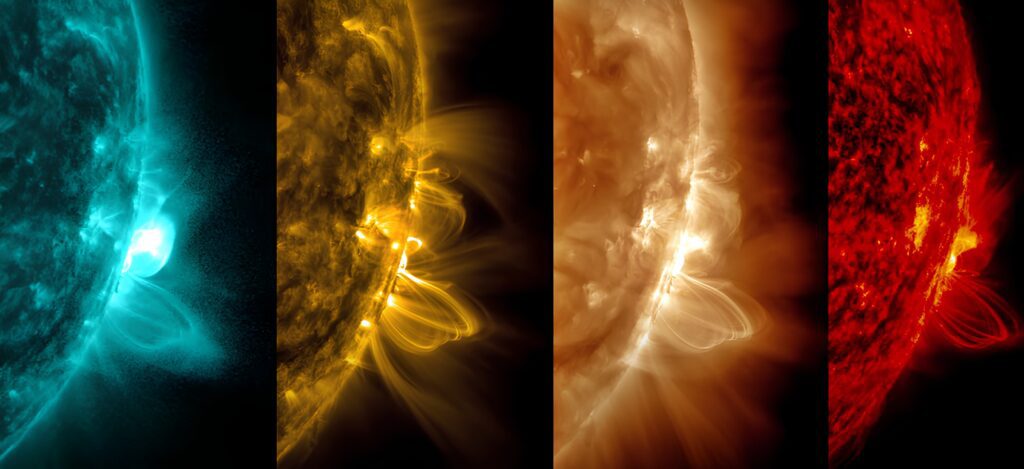In today’s current affairs, we delve into the global effort to track the strongest solar storm that recently hit Earth, causing the most powerful auroras seen in over 500 years. The Sun’s peak activity in its 11-year cycle led to a series of intense solar flares and coronal mass ejections, creating a historic solar storm. Scientists around the world were on high alert as they monitored the massive sunspot responsible for the storm, taking necessary precautions to safeguard assets in space. The impact of the storm resulted in stunning auroras visible in various parts of the world, making it one of the biggest solar events in decades. As we look to the future, NASA assures that Earth is now safe from any further impact, but the sunspot is now approaching Mars. It’s a reminder of the powerful forces at play in our solar system.
1. When did the strongest solar storm hit Earth, triggering powerful auroras?
– a. In the middle of May
– b. In the first week of May
– c. In late April
– d. In the second week of May
Answer: b. In the first week of May
2. What was the origin of the strongest solar storm that hit Earth?
– a. Sunspot AR3664
– b. Sunspot AR3663
– c. Sunspot AR3665
– d. Sunspot AR3666
Answer: a. Sunspot AR3664
3. How did scientists in India respond to the impending solar storm?
– a. Issued severe class space weather bulletin
– b. Alerted institutions associated with the AdityaL1 mission
– c. Tracked the activity of the Sun
– d. All of the above
Answer: d. All of the above
4. What did Nasa heliophysics citizen science lead Elizabeth MacDonald say about the CMEs?
– a. They arrived at different times
– b. They did not impact Earth
– c. They arrived largely at once
– d. They were weak in intensity
Answer: c. They arrived largely at once
Inside the global effort to track the strongest solar storm, which triggered the most powerful auroras seen in over 500 years.
During the first full week of May, a barrage of large solar flares and coronal mass ejections (CMEs) launched clouds of charged particles and magnetic fields toward Earth, creating the strongest solar storm to reach Earth in two decades. As they slammed into Earth’s magnetic field, they triggered one of the strongest displays of auroras on record in the past 500 years.
HOW IT ALL BEGAN
The Sun has reached peak activity in its 11-year cycle as it blasts off plasma and materials towards the inner and outer solar system without a pause. Earth was in the firing line when the strongest solar storm left the Sun in the first week of May.
They had accurately predicted it to happen in 2024. The first signs of an impending solar storm were observed on May 7 with two strong solar flares. From May 7-11, multiple strong solar flares and at least seven coronal mass ejections, the most powerful explosions from the Sun, stormed toward Earth.
SCIENTISTS ON ALERT
Scientists at the Center of Excellence in Space Sciences India (CESSI) were observing the activity of the Sun ramping up. Their calculations revealed that the mega sunspot contained four times higher magnetic flux, electric current and energy compared to a normal flare-producing active region. CESSI issued a rare severe class space weather bulletin immediately and alerted scientists at Isro and other institutions associated with the AdityaL1 mission, India’s maiden solar probe, to begin tracking and ensuring the safety of assets in space.
HOW BAD WAS IT?
Travelling at a staggering speed of 48 lakh kilometres per hour, the coronal mass ejections barrelled through space to slam into Earth. Starting May 10, the intense activity kicked off a stunning display of auroras in several parts of the world including India, the rarest of rare occurrences. Scientists compared it to one of the biggest solar events in decades and the aurora display was the best in over five centuries.
WHAT’S NEXT?
Nasa has said that the giant sunspot that triggered the storm is now on the other side of the Sun and Earth is safe from any impact. However, it’s not over yet. The sunspot is starting to come into view of Mars.
Today's Current Affairs revolve around the recent solar storm that triggered the strongest auroras seen in over 500 years. The Sun reached peak activity in its 11-year cycle, launching plasma and materials towards Earth. The storm, originating from sunspot AR3664, caused a series of powerful solar flares and coronal mass ejections, leading to a historic display of auroras. Scientists from around the world were on high alert, tracking the storm and ensuring the safety of assets in space. The US-based NOAA issued global alerts, and missions like Nasa's ICESat-2 and SpaceX's Starlink satellites took precautionary measures. Despite the intense activity, Earth is now safe from further impact as the giant sunspot moves towards Mars. Scientists are closely monitoring the situation for any future developments.






